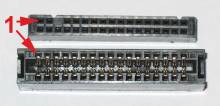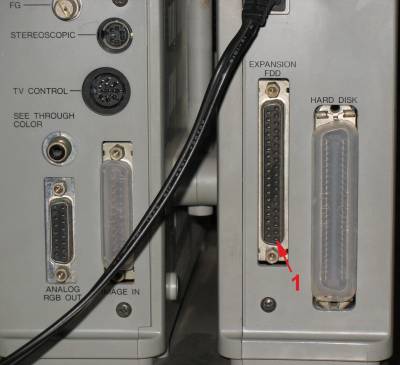X68000 Floppy Drive Pinout
The X68000 floppy drive uses PC-compatible drive hardware, with some special features like soft-eject and LED control. The external floppy drive connector on the X68000 is a DB37, which is a very unusual size, and it may be hard to locate, especially outside Japan.
You can use a PC Floppy Drive if you can do without the sexy extra features (soft-eject, das blinkenlights).
| Ext. | Int. | Signal | Dir. | Description |
|---|---|---|---|---|
| 1 | 2 | /Disk Type Select* | Out | Disk type selection signal |
| 2 | NC | NC | - | Not connected |
| 3 | 6 | /Drive Select 3 | Out | Drive selection signal 3 |
| 4 | 8 | /Index | In | Disk index signal |
| 5 | 10 | /Drive Select 0 | Out | Drive selection signal 0 |
| 6 | 12 | /Drive Select 1 | Out | Drive selection signal 1 |
| 7 | 14 | /Drive Select 2 | Out | Drive selection signal 2 |
| 8 | 16 | /Motor On | Out | Motor starting signal |
| 9 | 18 | /Direction | Out | Head moving direction signal |
| 10 | 20 | /Step | Out | Head movement signal |
| 11 | 22 | /Write Data | Out | Write data signal |
| 12 | 24 | /Write Gate | Out | Write gate signal |
| 13 | 26 | /Track 00 | In | Back to track 0 |
| 14 | 28 | /Write Protect | In | Write protect signal |
| 15 | 30 | /Read Data | In | Read data signal |
| 16 | 32 | /Side Select | Out | Head switching signal |
| 17 | 34 | /Ready | In | Drive ready signal |
| 18 | NC | NC | - | Not connected |
| 19 | NC | NC | - | Not connected |
| 20 | 1 | /Option Select 0* | Out | Option select 0 |
| 21 | 3 | /Option Select 1* | Out | Option Select 1 |
| 22 | 5 | /Option Select 2* | Out | Option select 2 (CZ-600C dedicated signal) |
| 23 | 7 | /Option Select 3* | Out | Option Select 3 |
| 24 | 9 | /Eject* | Out | Eject signal |
| 25 | 11 | /Eject Mask* | Out | Eject mask signal |
| 26 | 13 | /LED Blink* | Out | LED flashing signal |
| 27 | 15 | /Disk In* | In | Disk insertion signal |
| 28 | 17 | /ERR Disk* | In | Disk insertion error signal |
| 29 | 19 | /FDD INT* | In | Disk interrupt signal |
| 30 | GND | Ground | Out | Ground |
| 31 | GND | Ground | Out | Ground |
| 32 | GND | Ground | Out | Ground |
| 33 | GND | Ground | Out | Ground |
| 34 | GND | Ground | Out | Ground |
| 35 | GND | Ground | Out | Ground |
| 36 | GND | Ground | Out | Ground |
| 37 | NC | NC | - | Not connected |
* Not available on standard Shugart drives
Drive Selection
Drive selection occurs when a drive's DRIVE SELECT line is activated. Only the drive with this line active will respond to input lines or gate output lines.
Index
This interface signal is provided by the drive each time an index or sector hole is sensed at the Index/Sector photo detector. Normally, this signal is at a logical one level and makes the transition to the logical zero level each time a hole is sensed. There will be one pulse on this interface signal per revolution of the diskette and this pulse indicates the physical beginning of a track.
Motor On
In order for the host system to read or write data the DC drive motor must be turned on. This is accomplished by activating the line -MOTOR ON. A 0.5 second delay must be introduced after activating this line to allow the motor to come up to speed before reading or writing can be accomplished. The motor must be turned off by the host system by deactivating the MOTOR ON line. This should be done if the drive has not received a new command within two (2) seconds (10 revolutions of diskette) after completing the execution of a command.
Direction Select
This interface line defines direction of motion the read/write heads will take when the STEP line is pulsed. An open circuit or logical one defines the direction as “out” and if a pulse is applied to the STEP line the read/write heads will move away from the center of the disk. Conversely, if this input is shorted to ground or a logical zero level, the direction of motion is defined as “in” and if a pulse is applied to the STEP line, the read/write heads will move towards the center of the disk.
Step
This interface line is a control signal which causes the read/write heads to move with the direction of motion as defined by the DIRECTION SELECT line.
- Step Out - With the DIRECTION SELECT line at a plus logic level (2.4V to 5.25V) a pulse on the STEP line will cause the read/write heads to move one track away from the center of the disk.
- Step In - With the DIRECTION SELECT line at minus logic level (OV to .4V), a pulse on the STEP line will cause the read/write heads to move one track closer to the center of the disk.
Write Data
This interface line provides the data to be written on the diskette. Each transition from a logical one level to a logical zero level, will cause the current through the read/write heads to be reversed thereby writing a data bit. This line is enabled by Write Gate being active. Write Data must be inactive during a read operation.
Write Gate
The active state of this signal, or logical zero, enables Write Data to be written on the diskette. The inactive state or logical one, enables the read data logic and stepper logic.
Track 00
The active or logical zero state of this interface signal indicates when the drive's read/write heads are positioned at track zero (the outermost track) and the access circuitry is driving current through phase “A” of the stepper motor. This signal is at a logical one level, or inactive state, when the drive's read/write heads are not at track zero. When the drive's read/write heads are at track zero and an additional step out pulse is issued to the drive, a mechanical stop will keep the read/write heads at track zero but the TRACK 00 signal will go inactive. This is because the stepper motor will go to phase “C” and not phase “A”. One more step out pulse will put the stepper motor back into phase “A” and the TRACK 00 signal will go active again.
Write Protect
This interface signal is provided by the drive to give the user an indication when a Write Protected Diskette is installed. The signal is logical zero level when it is protected. Under normal operation, the drive will inhibit writing with a protected diskette installed in addition to notifying the interface.
Side Selection
Head Selection is controlled via the I/O signal line designated SIDE SELECT. A plus logic level on the SIDE SELECT line selects the read/write head on the lower side 0 of the diskette. A minus logic level selects the side 1 read/write head.
Ready
Signal indicating that FDD is ready to operate. This signal goes to LOW level, when the FDD is selected and the rotational speed of the floppy disk has reached 90% of the specification.
This page was originally located here.
Info also available here.
Signal descriptions were taken from here.




